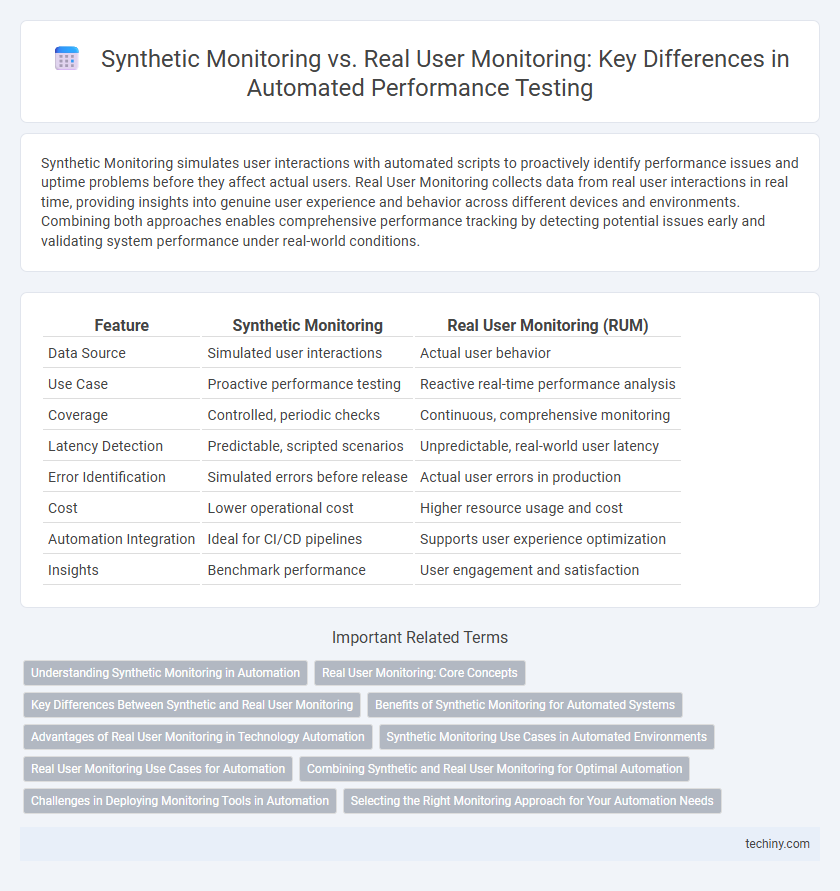Synthetic Monitoring simulates user interactions with automated scripts to proactively identify performance issues and uptime problems before they affect actual users. Real User Monitoring collects data from real user interactions in real time, providing insights into genuine user experience and behavior across different devices and environments. Combining both approaches enables comprehensive performance tracking by detecting potential issues early and validating system performance under real-world conditions.
Table of Comparison
| Feature | Synthetic Monitoring | Real User Monitoring (RUM) |
|---|---|---|
| Data Source | Simulated user interactions | Actual user behavior |
| Use Case | Proactive performance testing | Reactive real-time performance analysis |
| Coverage | Controlled, periodic checks | Continuous, comprehensive monitoring |
| Latency Detection | Predictable, scripted scenarios | Unpredictable, real-world user latency |
| Error Identification | Simulated errors before release | Actual user errors in production |
| Cost | Lower operational cost | Higher resource usage and cost |
| Automation Integration | Ideal for CI/CD pipelines | Supports user experience optimization |
| Insights | Benchmark performance | User engagement and satisfaction |
Understanding Synthetic Monitoring in Automation
Synthetic monitoring in automation involves using scripted transactions and simulated user interactions to proactively test and measure application performance, availability, and functionality. This method enables continuous, consistent monitoring independent of actual user traffic, providing early detection of issues before real users are affected. Synthetic monitoring tools generate reliable metrics on response times, transaction success rates, and system uptime, supporting automated incident management and performance optimization.
Real User Monitoring: Core Concepts
Real User Monitoring (RUM) captures actual user interactions and performance data from live website or application sessions, providing insights into user experience and behavior patterns. It measures metrics such as page load times, transaction success rates, and error frequencies based on real-time data from different devices and geographies. By analyzing this data, organizations can identify performance bottlenecks, optimize user journeys, and improve overall application reliability.
Key Differences Between Synthetic and Real User Monitoring
Synthetic Monitoring uses scripted tests to simulate user interactions and proactively detect performance issues before they affect real users, providing consistent and controlled data. Real User Monitoring captures actual user experiences in real-time, offering insights into true user behavior, diverse environments, and network conditions. Key differences include proactive versus reactive data collection, controlled simulations versus real-world variability, and synthetic monitoring's predictability compared to the dynamic and diverse data from real user monitoring.
Benefits of Synthetic Monitoring for Automated Systems
Synthetic Monitoring offers consistent, controlled testing environments that simulate user interactions 24/7, enabling proactive issue detection before real users are impacted. It provides comprehensive performance metrics across multiple geographic locations, ensuring global system reliability for automated workflows. This method supports continuous integration processes by delivering precise, repeatable data essential for optimizing automated system performance and uptime.
Advantages of Real User Monitoring in Technology Automation
Real User Monitoring (RUM) provides precise insights by capturing actual user interactions, enabling technology automation to identify performance bottlenecks and user experience issues in real-time. This data-driven approach allows for proactive optimization, reducing downtime and enhancing system reliability. Unlike Synthetic Monitoring, RUM reflects true end-user behavior, ensuring automated responses are aligned with genuine usage patterns and business outcomes.
Synthetic Monitoring Use Cases in Automated Environments
Synthetic monitoring enables proactive detection of system downtime and performance issues by simulating user interactions in automated test environments. It is essential for continuous integration and deployment pipelines, providing consistent, repeatable performance benchmarks without relying on actual user traffic. This proactive approach supports faster incident response and improves overall reliability in automated cloud and enterprise systems.
Real User Monitoring Use Cases for Automation
Real User Monitoring (RUM) captures and analyzes actual user interactions with websites or applications in real-time, providing precise data on performance, usability, and error occurrences. RUM is essential for automation in identifying user experience bottlenecks, optimizing page load times, and detecting specific device or browser-related issues under genuine conditions. Integrating RUM with automation workflows enhances proactive troubleshooting, supports continuous performance improvements, and ensures seamless digital experience delivery across diverse user environments.
Combining Synthetic and Real User Monitoring for Optimal Automation
Combining Synthetic Monitoring and Real User Monitoring (RUM) provides a comprehensive approach to automation by leveraging proactive performance checks alongside actual user behavior insights. Synthetic Monitoring simulates user interactions to detect potential issues before they affect end-users, while RUM captures real-time data from live users, offering detailed visibility into authentic performance metrics. Integrating both techniques enhances problem detection, optimizes application reliability, and ensures seamless user experiences through continuous, automated monitoring workflows.
Challenges in Deploying Monitoring Tools in Automation
Deploying Synthetic Monitoring and Real User Monitoring tools in automation faces challenges such as ensuring accurate simulation of user interactions and capturing diverse user behaviors across platforms. Synthetic Monitoring struggles with replicating dynamic content changes, while Real User Monitoring must handle massive data volumes and privacy concerns. Balancing resource consumption and maintaining minimal impact on application performance remain critical hurdles in automated monitoring implementations.
Selecting the Right Monitoring Approach for Your Automation Needs
Synthetic Monitoring simulates user interactions through scripted tests, providing consistent performance data and early detection of issues, making it ideal for proactive automation strategy and controlled testing environments. Real User Monitoring (RUM) captures actual user behavior and experiences in real-time, offering valuable insights into application performance under diverse conditions and user demographics. Selecting the right approach depends on automation priorities: use Synthetic Monitoring for baseline performance metrics and reliability checks, while RUM suits optimization based on real-world user interactions and load variability.
Synthetic Monitoring vs Real User Monitoring Infographic

 techiny.com
techiny.com